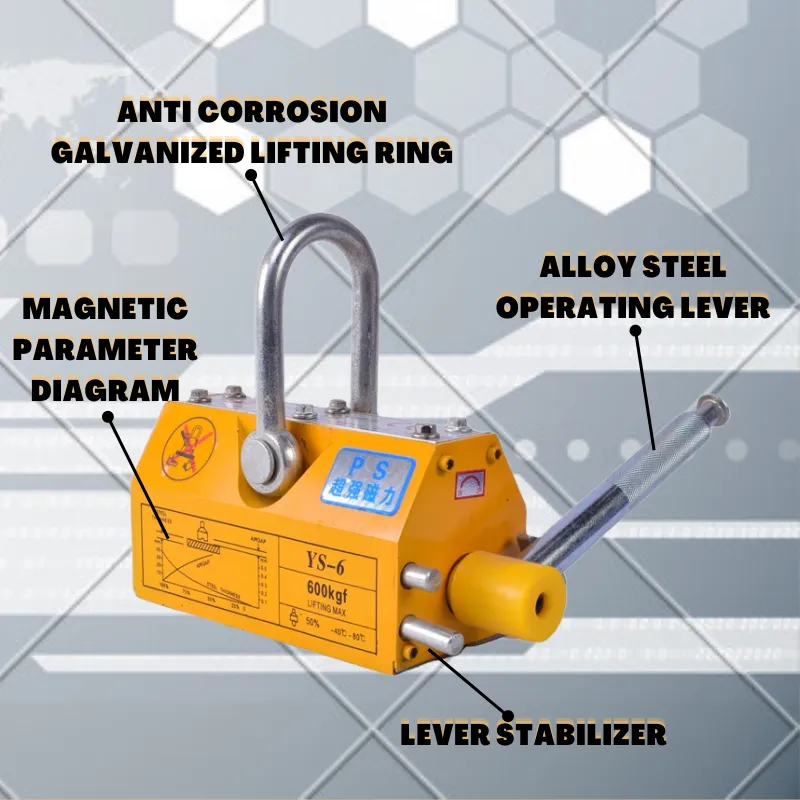Selecting the Best Lifting Magnets for Crane Applications and Safety Considerations
Lifting Magnets for Cranes Enhancing Efficiency in Material Handling
In the modern industrial landscape, the efficiency of material handling systems is paramount. Among the tools that have significantly streamlined these operations are lifting magnets, particularly when coupled with cranes. These powerful devices are designed to lift, carry, and transport ferrous materials, making them indispensable in various applications, from construction sites to manufacturing facilities.
Understanding Lifting Magnets
Lifting magnets function on the principle of electromagnetism. When electricity flows through the coils of a magnet, a magnetic field is generated, allowing it to adhere to ferrous materials such as steel plates, pipes, and other iron products. This technology contrasts sharply with traditional lifting methods, which often rely on hooks, slings, or other mechanical attachments that can be cumbersome and less efficient.
The significant advantages of using lifting magnets are evident. They provide a secure grip on loads, reducing the risk of accidents caused by slippage or dropping. This ability becomes even more crucial when handling heavy or bulk materials, where the stakes are high, and safety is a priority. Moreover, because lifting magnets can quickly engage and release loads, they contribute to enhanced productivity by minimizing downtime during material transfers.
Types of Lifting Magnets
lifting magnets for cranes

There are primarily two types of lifting magnets used in conjunction with cranes permanent magnets and electromagnetic magnets. Permanent magnets are designed to hold loads without requiring a power supply, making them ideal for situations where electricity may not be readily available. They are simple to operate and are often used for lighter loads and shorter lifting cycles.
On the other hand, electromagnetic lifting magnets are more versatile and powerful. They can be turned on and off, allowing for a greater range of applications. These are particularly useful in environments where the payload varies significantly or where heavy-duty lifting is required. Their adjustable grip strength offers more control over the lifting process, thereby enhancing safety and efficiency.
Applications in Industry
Lifting magnets find extensive applications across various sectors. In the steel industry, they are used to move steel sheets and plates efficiently during fabrication processes. In construction, they can handle rebar and other ferrous materials, helping to speed up the assembly and placement tasks. Additionally, recycling facilities utilize these magnets to separate ferrous materials from non-ferrous ones, streamlining the sorting process.
Conclusion
As industries continue to evolve, the importance of adopting advanced material handling solutions, such as lifting magnets for cranes, cannot be overstated. With their ability to increase efficiency, enhance safety, and reduce labor costs, lifting magnets offer a robust solution for modern material handling challenges. By integrating these devices into their operations, companies can not only improve their productivity but also create a safer work environment for their employees. Embracing such technology is a step toward a more efficient and effective industrial future.
-
Unlock Seamless Relocation with Our Heavy Equipment Moving ExpertiseNewsJun.06,2025
-
Unleash Unrivaled Flexibility with Our Adjustable Gantry CraneNewsJun.06,2025
-
Unleash Heavy-Duty Efficiency with Our Industrial Gantry Crane SolutionsNewsJun.06,2025
-
Revolutionize Steel Handling with Our Magnetic Lifter RangeNewsJun.06,2025
-
Master Equipment Mobility with Premium Machinery Mover SolutionsNewsJun.06,2025
-
Elevate Your Material Handling with Magnetic Lifter TechnologyNewsJun.06,2025
-
YS Permanent Lifting Magnets: The Smarter Way to Handle SteelNewsMay.22,2025
